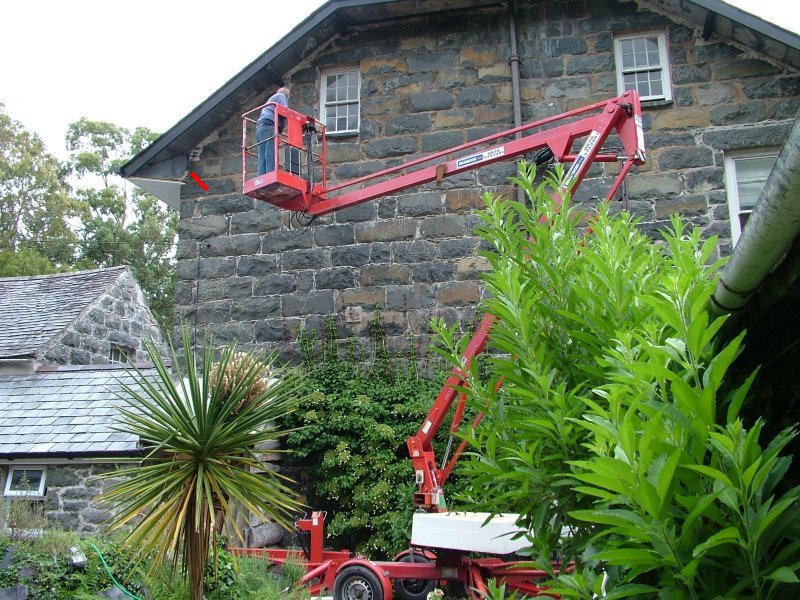
Vacuum removal of a honey bee colony from a house eaves while cutting out the comb
The colony had to be removed because the soffits below it were being renewed. The initial intention was a cutout of the colony and tying the combs intio National frames. However, the limited access to the cavity and cramped space in the cage of the cherry picker made it necessary to remove the colony by bee vacuum, and cut out the combs as the bees were being removed. The bee vacuum generally saves most of the bees of a colony, though does not always ensure it is queen right.

12 July, 10.11 a.m.: The 'chery picker' hirer checks that it reaches the colony site 7 metres (23 ft.) above ground. The main entrance to the colony was to the left of the red bar.
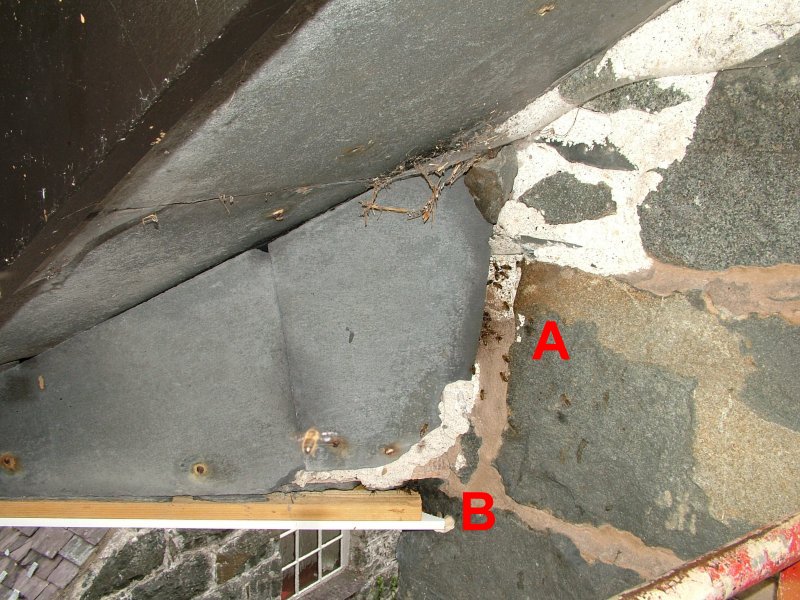
10.59 a.m.: the bees were accessing the cavity behind a slate, mainly at 'A' in the above photo, but to some extent at 'B'.
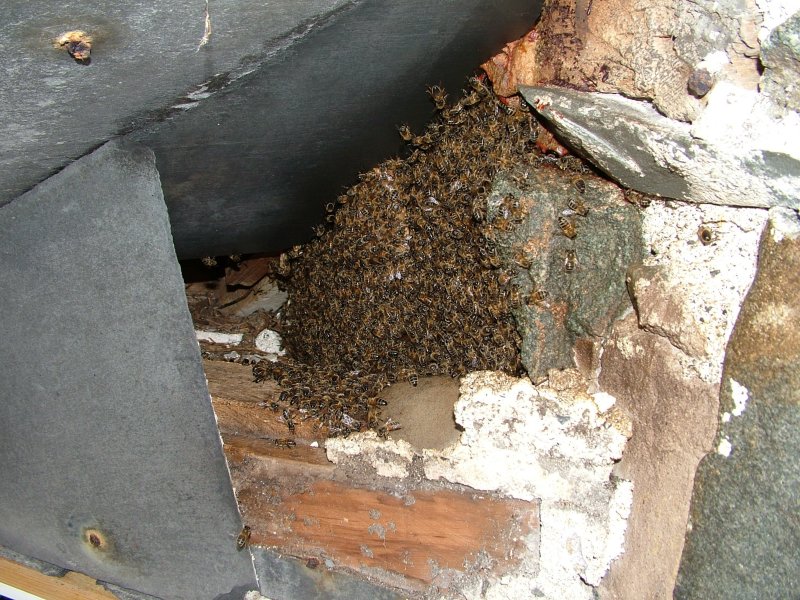
11.08 a.m.: first slate removed, revealing the outside of the colony. A typical colony in this region at this time of year would have 50,000 or more worker bees if it has not swarmed.
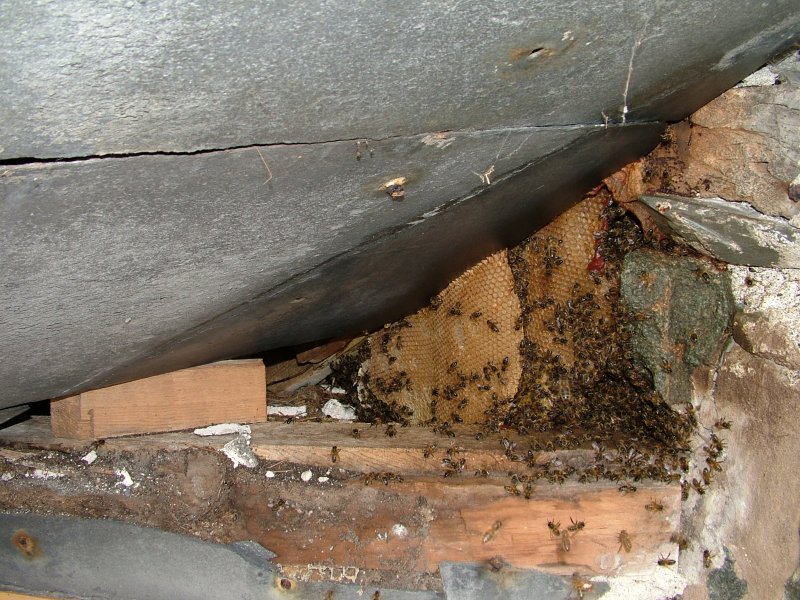
11.52 a.m.: After prolonged vacuuming of the bees into a bee vacuum the outer combs were exposed for long enough to get a photo of them. Bees continued to crowd towards the entrance during the comb removal, and vacuuming was continued as necessary until the colony was removed.
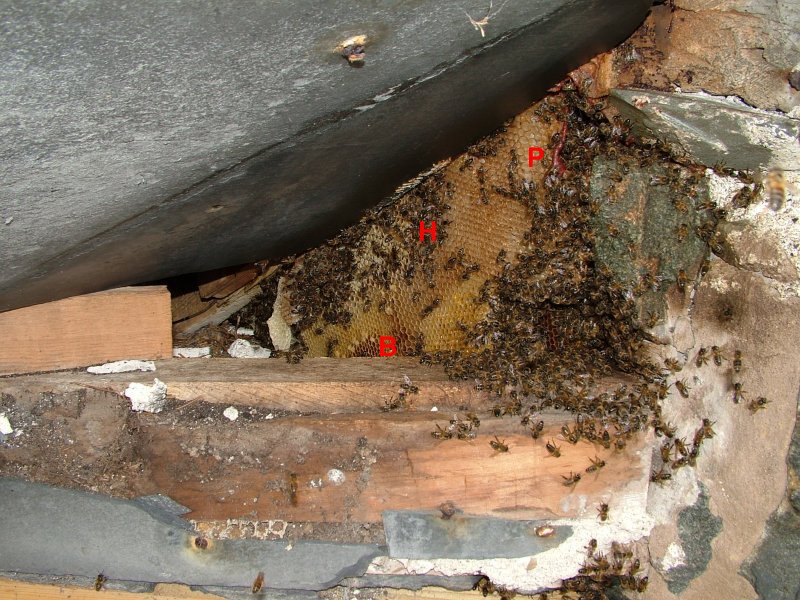
12.09 p.m.: the first comb has been removed. Removed combs were deposited in buckets and plastic sacks. On comb 2 can be seen some capped worker brood (B), capped honey (H) and a streak of propolis (P) the bees' antiseptic sealant made from wax mixed with resin collected from plants.
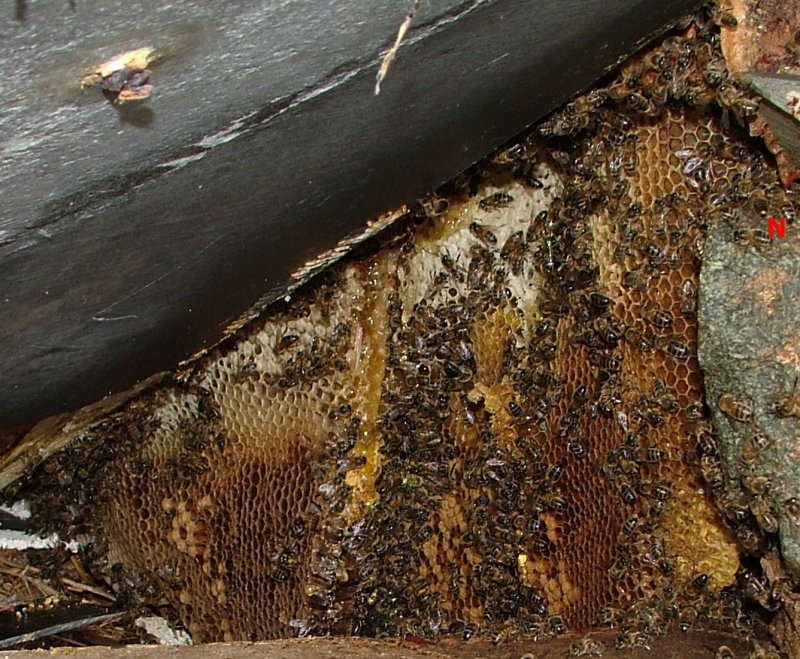
12.47 p.m.: after more vacuuming, half the second comb is removed exposing the third with a larger area of capped worker brood and honey above. A worker (N) can be observed in the top right scenting from the Nasanov gland (light spot) on the rear of its abdomen. By this stage the workers are aware that there is intense disruption to the colony and they are sending out pheromone to guide scattered bees back into the nest.
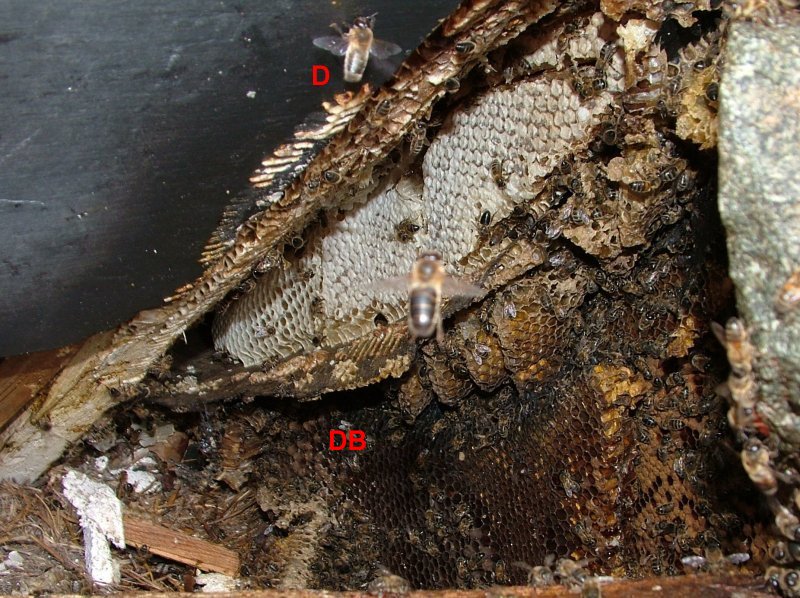
3.34 p.m.: The fourth comb is removed and part of the fifth. We have reached the middle of the brood nest. The comb is very dark, almost black, indicating that the colony is at least a year old, possibly older. At the top is a drone standing on the gable soffit slate. In the forefront is a drone in flight. The colony was extraordinarily well stocked with drones. In the mid-afternoon there was a flight of swarm of drones immediately outside the cavity, swaying in the air. Presumably they did not emerge from the rear of the colony during the initial vacuuming, and were taking their customary daily flight near the entrance in the warmest part of the day.
Above a flap of roofing felt, which presumably acted as a queen excluder, there is a large slab of honeycomb which has never had brood in it. Lots of capped worker brood is visible on the sixth comb (bottom right). The fifth comb has been cut in the region of yellow coloured cells filled with bee bread, a fermented mixture of pollen and honey. To the left of the letters 'DB' are some cells with raised cappings. These are brood cells of the larger male bee, the drone.
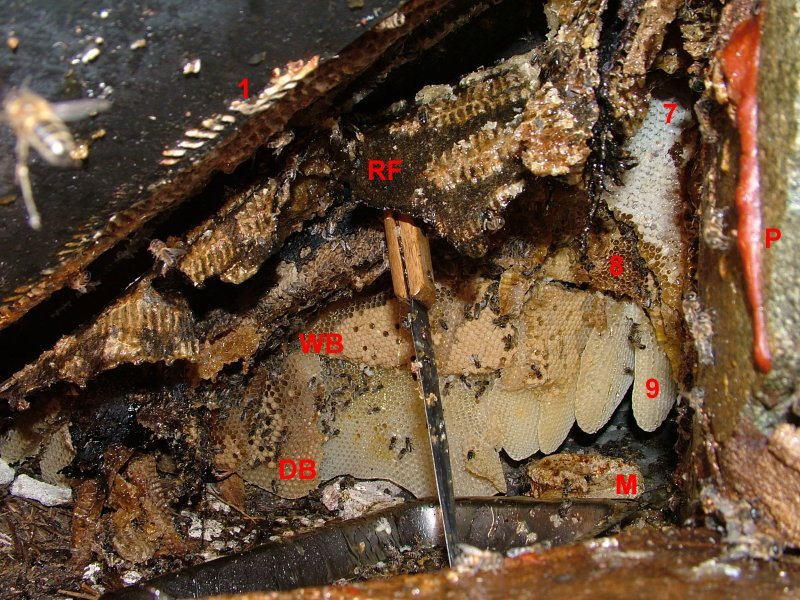
5.34 p.m.: the last combs are exposed. The knife is holding a flap of roofing felt (RF) out of the way of the view of the last combs.
KEY: 1. anchor point of first comb; DB -- patch of drone brood; WB -- worker brood; 7-9 -- combs 7-9; P -- propolis streak.
Here most of combs 7 and 8 have gone revealing a new outer comb, obviously fresh this season. The object 'M' just beyond the nest was thought to be a piece of fallen comb but it turned out to be a lump of lime mortar.
The wall in the nest area is coated with a thin film of propolis. This shows more clearly in the next photo.
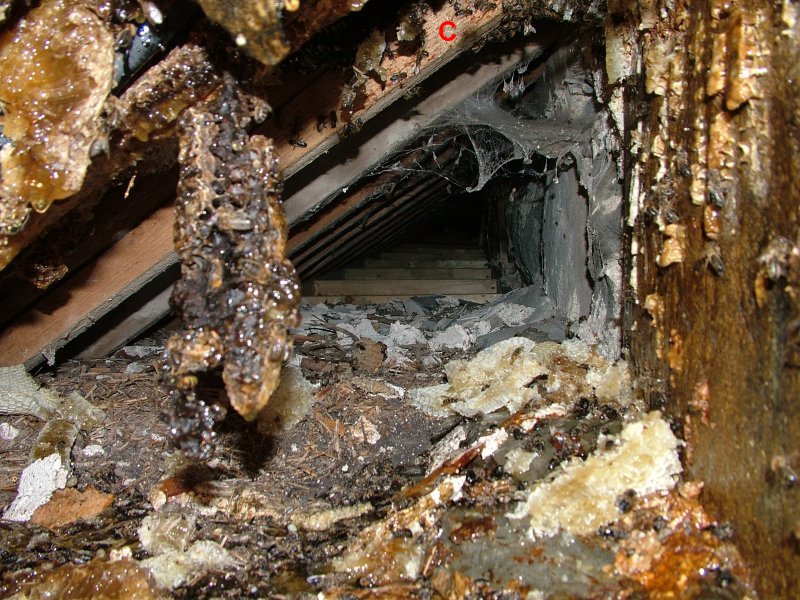
8.22 p.m. the nest is essentially removed. By mid afternoon the spilt honey had attracted a large number of robbers from neighbouring honey bee and wasp colonies in the locality. Therefore, only a limited amount of vacuuming was done in the late afternoon to avoid taking visiting bees into the vacuum. However, in case there was a residual cluster of the 'rightful owners' of the nest, a further visit was made mid-evening, by which time most bees would have returned to their colonies. There was indeed a small cluster (C) of bees on the top of the second rafter in from the entrance. These bees were taken into the vacuum.
The view down the soffit tunnel shows in the distance the battens supporting the newly installed soffits. The comb attachments can be seen on the wall on the right. There is a strip of roofing felt hanging down in the foreground, covered in honey and beeswax. Comb fragments, birds nest materials, and bits of mortar litter the floor of the cavity.
Residual honey was left to the robbers expected the following day (13 July). However, robbing and the intended work on the soffits, was partly hampered by rain showers. Robbers were still active in a sunny spell the day after that, when most of the work was completed. It was decided to leave the final sealing up of the cavity until the following day (14 July) to allow the honey to be removed by the robbers. Residual comb will eventually be destroyed by wax moths, whom a healthy colony keeps at bay, but who move in when the comb is no longer defended by the bees.
As the former access to the nest was not fitted with new soffits until the morning of 15 July a final inspection was made prior to spraying with Fischer's 'Bee Quick' a bee repellent.
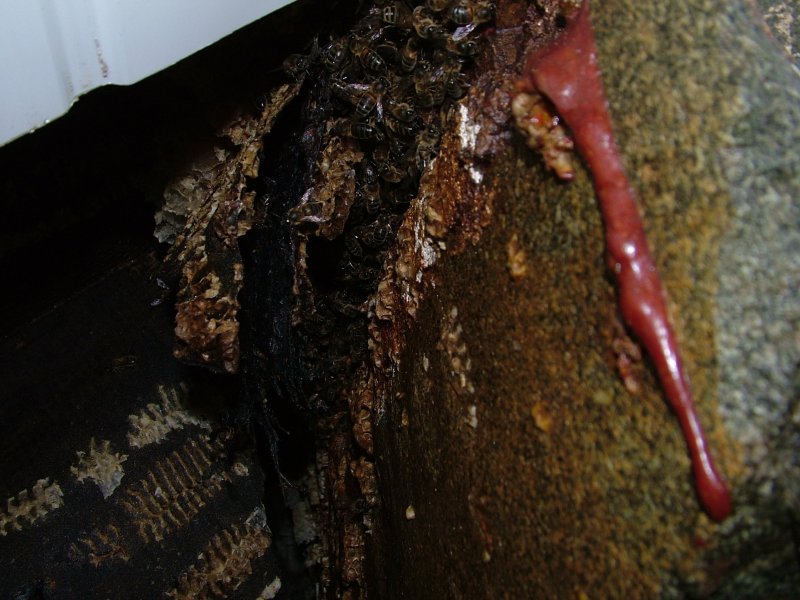
Unfortunately a small cluster of residual bees (above photo) was detected along the top corner of the cavity where the wall meets the roof. These were taken into the bee vacuum before spraying the cavity and letting the joiner close it up with the new soffits and silicone sealant.
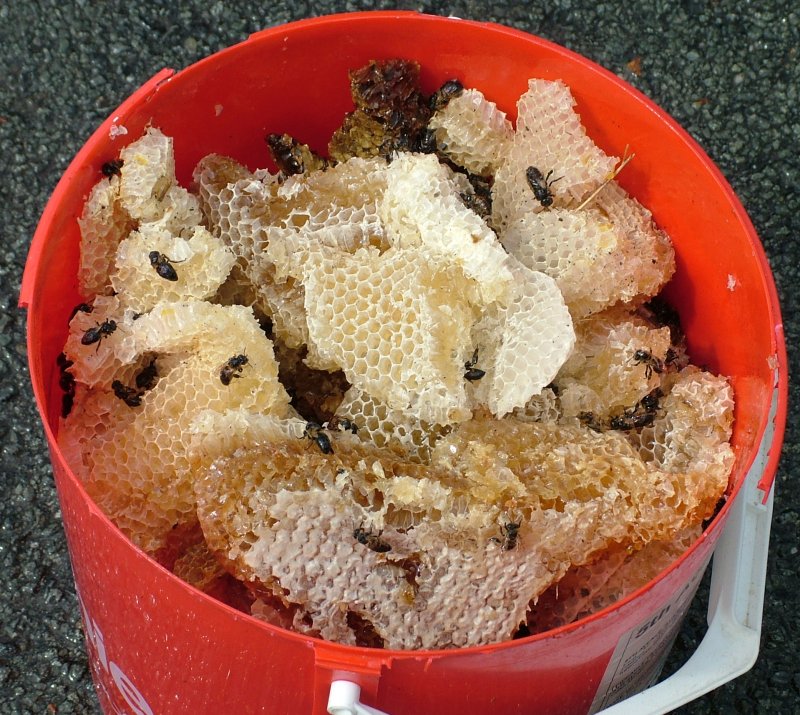
Above: some of the comb removed. The lower fragment has cells capped with beeswax, showing that it is ripe and was laid down as stores, especially for winter survival of the colony. Above that is comb with cells that are not capped. This honey usually has a higher moisture content and is not ripe for long-term storage.
The estimated volume of the nest is 48 litres. The total weight of comb removed was 23.9 kg (53 pounds).
The bees taken into the bee vacuum were donated to a local beekeeper who hived them more than 3 miles from their origin. This ensured that no foragers returned to their old nest site.